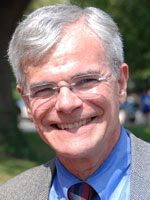Q and A with Dr Michael M Gottesman, NIH Deputy Director for Intramural Research
September / October 2014 | Volume 13, Issue 5

Dr. Michael M. Gottesman,
NIH Deputy Director for
Intramural Research
As NIH Deputy Director for Intramural Research, Dr. Michael M. Gottesman leads the office responsible for overseeing and coordinating NIH's internal research, recruiting skilled scientists from around the world and training the next generation of biomedical and behavioral investigators. He also heads the National Cancer Institute's (NCI) Laboratory of Cell Biology and has contributed to key discoveries, including how cancer cells resist destruction by several widely used chemotherapy drugs. He obtained his M.D. from Harvard Medical School and came to NIH in 1971 for postdoctoral research training in molecular genetics.
What is the Office of Intramural Research's role?
The office oversees all NIH's intramural research, training and technology transfer activities and additionally develops and implements NIH-wide projects, policies, standards and reviews for this research. By funding its own research, NIH facilitates long-term, high-impact science that few other institutes are in a position to support. From this research, we've had discoveries important to domestic and global health, such as fluoride's role in protecting teeth, the use of lithium for bipolar disorder, treatments for multiple sclerosis and development of important vaccines for hepatitis, rotavirus, typhoid and the human papilloma virus (HPV).
Why are foreign scientists important to NIH?
We welcome scientists from other countries as an important part of building research capacity globally, whether the scientists remain in the U.S. or return home. Look to your right and your left in the labs or clinics at NIH and you are likely to spot a scientist who was born outside the country and received their primary training elsewhere. About 40 percent of our approximately 7,000 scientists and trainees are foreign nationals from more than 100 countries. In fact, over 60 percent of NIH's 4,000 postdocs come from abroad, especially China, India, Japan, Korea and European nations. And many of our 1,100 principal investigators were also born outside of the U.S.
What attracts them to NIH?
The desire of these foreign scientists for an outstanding research experience is matched by our open and inclusive attitude towards our international colleagues in providing opportunities, including salary and research support, to pursue important investigations. The NIH intramural research program is perceived as being one of the top facilities in the world. For many foreign researchers, a successful postdoctoral experience at NIH is often a ticket to future success in a scientific career either back home or in the U.S.
How are they supported on campus?
NIH has a Visiting Fellows Committee that helps foreign scientists transition to life at NIH and enjoy a worthwhile experience. It also works to create opportunities for visiting fellows to maintain continuity in their research on returning to their home countries and encourages strong links between the fellows' home institutions and NIH. For instance, the group organizes informal and formal meetings and seminars with visiting scientists and science-related organizations to help the fellows stay in touch with the international science community and identify opportunities abroad.
How do the exchanges spur science globally?
NIH has a long history of celebrating our international colleagues by learning more about their cultures and by forming lifelong friendships and collaborations. We all benefit from what an international cadre of scientists has to offer - a kaleidoscope of cultures, religions, abilities and disabilities, worldviews and perceptions that can be harnessed to solve almost every problem that nature has thrown our way. At NIH, our international community brings many different points of view to bear on important problems in basic biology, public health and clinical practice. Some examples include the teams of NIH's U.S. and foreign scientists who cracked the genetic code, developed cancer chemotherapy, or responded to the HIV epidemic. We are fortunate to have a wonderful tapestry of culture and intellect in our scientific community.
How do these partnerships work?
One of the strong indications of the value to the global research effort of a research experience at NIH is the fact that more and more countries are developing programs to send their postdocs here for advanced training. For nearly 20 years, we have partnered with the Japan Society for the Promotion of Science (JSPS) and we also have a long-standing agreement to train Canadian fellows who can later earn independent positions in Quebec. Newer programs with Russia, Brazil and Korea provide varying levels of support to allow their fellows to work in NIH laboratories.
There are many examples of successes by foreign scientists, including discoveries about the molecular mechanism of Parkinson's disease by Japanese scientists, development of a bi-transgenic mouse model for cancer by a Brazilian postdoctoral fellow, and neurocircuitry behind itching studied by a research fellow from India. The strength of this institution reflects the importance of the global community of scientists at the NIH.
More Information
To view Adobe PDF files,
download current, free accessible plug-ins from Adobe's website.